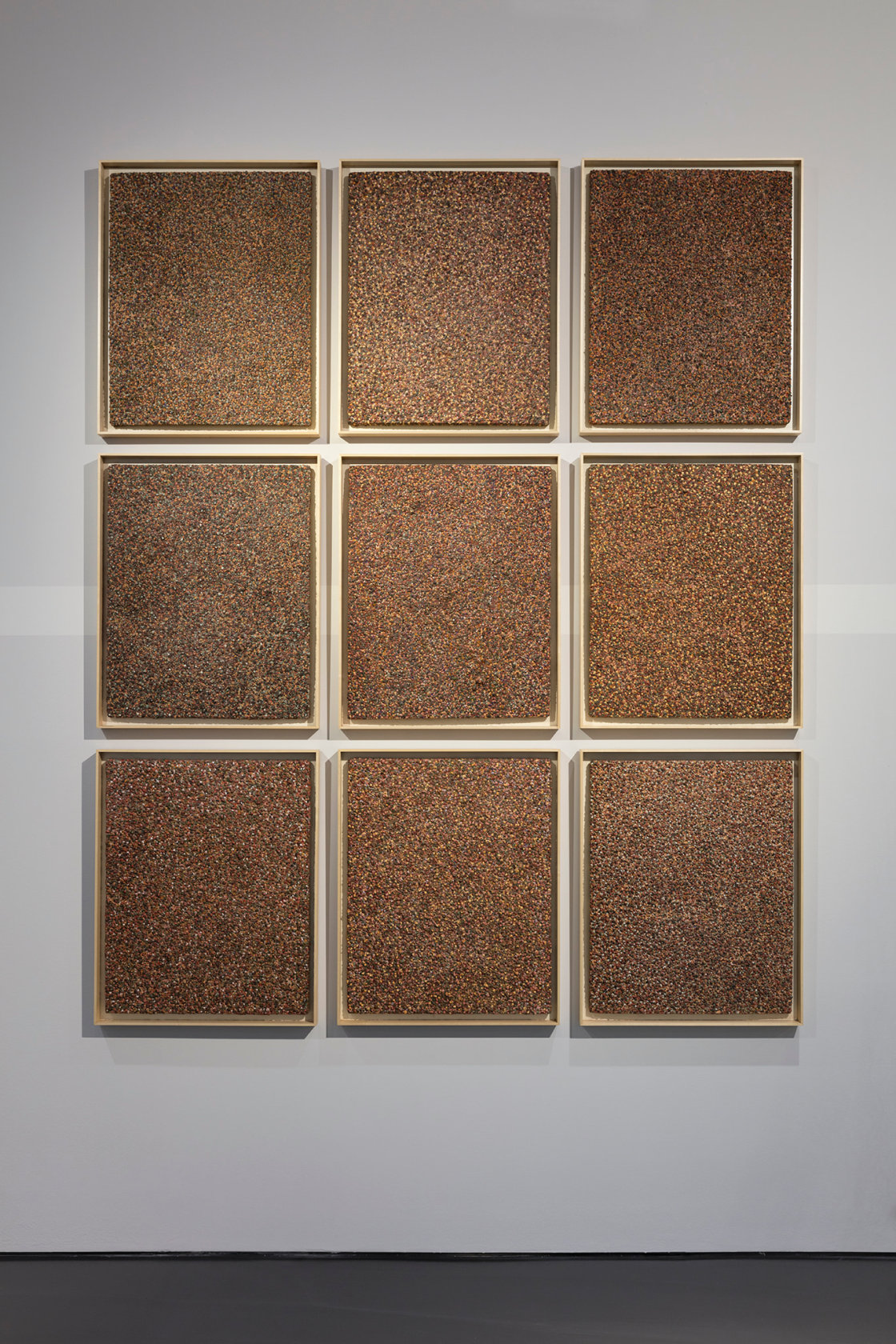General Idea El Dorado Series, 1992
Tinted hydrostone on extruded Styrofoam
Set of 9 panels
76,2 x 61 cm (29 7/8 x 24 1/8 in) each (9 parts)
76,2 x 61 cm (29 7/8 x 24 1/8 in) each (9 parts)
El Dorado is a set of nine abstract paintings made of tinted hydrostone on extruded Styrofoam that were produced in 1992.
The title, El Dorado, refers to the mythical city of gold that lured 16th century Spanish conquistadors into the then-uncharted territories of South America.
The nine tones of the different colored hydrostone painting are pointillist interpretations of 18th century Spanish “caste” paintings in the collection of Museo Nacional de Antropología, Madrid, first commissioned during the reign of Philip V of Spain (1700-1746) to map out the development of different interracial ethnic groups in South America, as a result of European colonialism.
Each of the nine panels has a subtitle identifying the specific type of ethnicity commonly attributed in the historical genre to a skin tone. The subtitles of the nine works are:
Albarazado ("De Coyote y morisco sale albarazado")
Albino ("De morisco y espanol sale morino")
Coyote ("De cuarteron y mestizo nace coyote")
Cuarteron ("De mulato y mestizo sale cuarteron")
Lobo ("De negro y indio sale lobo")
Mestizo ("De espanol y indio sale mestizo")
Morisco ("De espanol y mulato sale morisco")
Mulato ("De espanol e de negro sale mulato")
Sombujo ("De lobo y indio sale sombujo")
The El Dorado series is also closely related to General Idea’s 1991 Maracaibo: ten collages of an extensive photographic archive belonging to a Venezuelan businessman who died of AIDS in 1988. The series of snapshots—representing hundreds of men of different skin color, either nude or dressed—was found by General Idea who appropriated it. Appropriation was central to many of General Idea’s artworks: the group drew on formats and aesthetics from sources in popular culture, archeology, and fine art.
The work raised pressing and provocative questions linked to homosexuality, AIDS, class, and race. As described by Ivo Mesquita: “that material brought a new perspective to GI’s imagery and practices, one tied to cultural differences and differences in behavior, issues of class and race that arose through contact with a non-Anglo-Saxon context […] They wanted to restore the history of those bodies, to try to find a place for them in memory, a place that would not exclude them from history or hide the inequality that they represent.” (‘General Idea: Pages of History,’ Tiempo Partido, Buenos Aires: MALBA, 2017, app. p. 17)
PRIVATE COLLECTION:
Capamulato [“Mulato è indio engendran capamulato”], Norberto Dotor Pérez, Galería Fúcares, Madrid
The title, El Dorado, refers to the mythical city of gold that lured 16th century Spanish conquistadors into the then-uncharted territories of South America.
The nine tones of the different colored hydrostone painting are pointillist interpretations of 18th century Spanish “caste” paintings in the collection of Museo Nacional de Antropología, Madrid, first commissioned during the reign of Philip V of Spain (1700-1746) to map out the development of different interracial ethnic groups in South America, as a result of European colonialism.
Each of the nine panels has a subtitle identifying the specific type of ethnicity commonly attributed in the historical genre to a skin tone. The subtitles of the nine works are:
Albarazado ("De Coyote y morisco sale albarazado")
Albino ("De morisco y espanol sale morino")
Coyote ("De cuarteron y mestizo nace coyote")
Cuarteron ("De mulato y mestizo sale cuarteron")
Lobo ("De negro y indio sale lobo")
Mestizo ("De espanol y indio sale mestizo")
Morisco ("De espanol y mulato sale morisco")
Mulato ("De espanol e de negro sale mulato")
Sombujo ("De lobo y indio sale sombujo")
The El Dorado series is also closely related to General Idea’s 1991 Maracaibo: ten collages of an extensive photographic archive belonging to a Venezuelan businessman who died of AIDS in 1988. The series of snapshots—representing hundreds of men of different skin color, either nude or dressed—was found by General Idea who appropriated it. Appropriation was central to many of General Idea’s artworks: the group drew on formats and aesthetics from sources in popular culture, archeology, and fine art.
The work raised pressing and provocative questions linked to homosexuality, AIDS, class, and race. As described by Ivo Mesquita: “that material brought a new perspective to GI’s imagery and practices, one tied to cultural differences and differences in behavior, issues of class and race that arose through contact with a non-Anglo-Saxon context […] They wanted to restore the history of those bodies, to try to find a place for them in memory, a place that would not exclude them from history or hide the inequality that they represent.” (‘General Idea: Pages of History,’ Tiempo Partido, Buenos Aires: MALBA, 2017, app. p. 17)
PRIVATE COLLECTION:
Capamulato [“Mulato è indio engendran capamulato”], Norberto Dotor Pérez, Galería Fúcares, Madrid
Scroll

